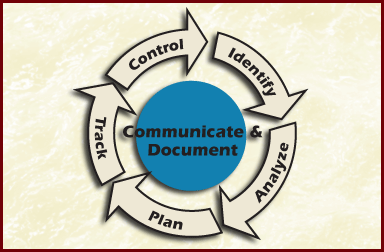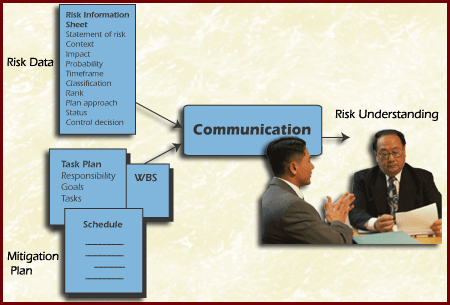
Communicate and Document
The objectives of communication are for project personnel to:
Lets go back and visualize Roger L Van Scoy's paradigm [Van Scoy 92, p.9] and what he said about the Communication element. To refresh your memory, Van Scoy said:

Figure Communication Management
Paradigm
"Risk communication is at the center of our paradigm because, without effective communication, no risk management approach is viable. Communication is critical because it facilitates interaction among the elements of the paradigm. But there are higher-level communications to consider as well. Risks must be communicated to the appropriate organizational levels so the risks can be analyzed and managed effectively. This includes levels within the development organization, within the customer organization, and most especially, across that threshold between the developer and the customer."
The paradigm illustrates a set of functions that are identified as continuous activities throughout the life cycle of a project. The Communication element is highlighted in Figure Communication Risk Management Paradigm.
Communication and documentation are present in all of the other functions of the risk management paradigm and are essential for the management of risks within an organization.
Communication of risk information is often difficult because the concept of risk deals with two subjects that people don't normally communicate well: probability and negative consequences. Communication is present in all of the other functions of the risk management paradigm and is essential for the management of risks within an organization. It must both fit within an organization's culture as well as expose the risks, which are present in an organization's projects.
The interview activity used in the Identify function communicates risk information by determining what the project's risks are and then documenting the risk statements and their contexts.

Figure Communication exemplifies communication activities.
There are several ways in which risk information can be shared between personnel on a project, including both formal and informal methods of communication. The categories of risk communication include: general, management, team, and external. They are defined in the Table Types of Communication.
|
Types of Communication |
Description |
|
General |
General communication applies to both internal and external risk communication. It includes peer-to-peer, intra-group, and internal organizational communication. Example: Two software engineers informally discuss the interface between their software modules. They are interested in understanding the impact of their module designs on the interface and in identifying any risks that may be present. |
|
Management |
Management communication is for internal project communication among all levels of the project staff. Example: A systems engineer reports risks to his/her supervisor. |
|
Team |
Team communication covers communication within small teams. They can be internal project teams, improvement teams, or integrated product teams. Example: An integrated product team is assigned the responsibility to design and develop a communication satellite operating system. The team members agree to include a discussion of the project's top N risks at their weekly team meetings. |
|
External |
External communication deals with the formal and informal communication between the project and its external customers), supplier(s), and senior organization managers). Example: In Continuous Risk Management, project personnel communicate risk information with a supplier who will be part of the risk mitigation strategy and with the customer who needs to be aware of how the most important risks are being mitigated. |
The core principle of the seven principles of Continuous Risk Management is open communication. Risk management communication requires:
The power of effective communication can most readily be seen when multiple viewpoints come together to form a common understanding. The formation of a common understanding does not necessarily require agreement among all parties. People can still disagree on issues, but they can also understand other points of view with respect to those issues.
Successful risk communication raises the level of understanding of relevant issues or actions on a project. As a result, project personnel feel that they are adequately informed about project issues [NRC 89].
When good communication is encouraged within an organization, it provides a solid foundation for the communication of risks within the organization's projects. For risk communication to be considered good [Covello 93], it must:
Management plays a significant role in creating and sustaining an environment and culture that enhances communication. This is particularly true for risk communication. In Table Enabler each of the following environmental and cultural aspects helps to enhance risk communication in an organization.

Table Enabler
|
Enabler |
Description |
|
Defining clear project roles and responsibilities |
The organizational structure is clarified by defining the positions, roles, and responsibilities within the organization. Defined roles help to identify sources of information within an organization and to create a process for dealing with risks. |
|
Making risk actions and decisions visible |
Current risk status information is made available to the entire project team in an easily understood format. This sustains the motivation of project personnel to be proactive and helps to institutionalize the practice of risk management. |
|
Being a role model |
Risk actions and decisions are communicated to project personnel. Project leaders must set an example for the project team. |
|
Establishing an internal champion |
An advocate of the risk management practice is identified. An internal champion is needed to provide the continual day-to-day encouragement to the project, to lead the drive for improvement, and to sustain the motivation for risk management. |
|
Rewarding positive behavior |
People who communicate risk information are rewarded. When behavior is rewarded, it tends to be reinforced and sustained in the future. Example: People should be rewarded when they identify risks, because they will have an incentive to identify more risks in the future. |
While management plays a significant role in creating and sustaining an environment that enhances communication, it also plays a significant role in removing barriers to risk communication. Barriers to risk communication along with suggested remedies are described in the Table Barriers.

Table Barriers
|
Barrier |
Description |
Remedy |
|
Ready-fire-aim |
People provide solutions to a problem before they have assembled and understood the underlying facts and context of the problem. |
Project personnel must first try to understand the issues before they draw conclusions. They need to separate fact finding from the process of generating solutions. Conducting an investigation and applying the results to potential solutions can be an iterative process. |
|
Don't tell me your problem |
People often require a solution before they even discuss an issue. Example: A manager says, "Don't bring me problems, bring me solutions." |
Management must create an environment where issues can be raised and addressed openly. Managers need to clarify roles and responsibilities within their organizations. |
|
Shoot the messenger |
A project member who intends to inform others or who is seeking help can suffer negative consequences because he/she is communicating unpleasant information. Example: An individual takes an issue to the project manager and is told to bring back more information (the same information the individual was seeking). |
Management must create an environment where issues, problems, and risks are discussed without assigning blame. However, actions that do not blame an individual (e.g., a request for more information) can also be a source of punishment under some circumstances. |
|
Liar's poker |
Project personnel identify risks, but fail to communicate them to others. Instead, they wait until the risks become serious problems, which impact project schedules and product quality. Example: Rather than communicating bad news to a manager about a potential problem, a team member waits for the problem to occur and for someone else to fail. |
Management must create an environment of trust where failures are tolerated, but not repeated (lessons are then learned). |
|
Mistrust |
Individuals do not trust each other for a variety of reasons (e.g., past history, preconceived biases, personal biases, political factors, etc.). This lack of trust can reduce or destroy any credibility in the acquired risk data, which by its nature is subjective and speculative. |
Management must encourage team building. Team members must develop good histories of communicating facts. This will then establish credibility and trust among the staff. |
|
Value differences |
Individuals have their own personal value systems. They measure and compare messages and information based on their individual values. |
Management must identify individual values and differences. Managers must develop project values using consensus-based processes. |
|
Hidden agendas |
Situations create individual preferences for results. Individuals or groups may promote facts or arguments based on their goals rather than for the common good. Example: A manager may be influenced to defer a decision, asking for additional funds to resolve a problem because his/her merit increase would be affected. |
Management must identify relevant interests and preferences among project personnel. Managers must build a culture where alternatives are explored, and they must also ensure that the reward system is consistent with desired outcomes. |
|
Differential knowledge |
Each individual has a differing understanding of an issue. |
Management must create cultural values that encourage individuals to share knowledge and to conduct analyses as appropriate. This will help to develop a common understanding of project issues among team members. |
|
Placing blame |
Risk information is abused because it is used to place blame on project personnel. |
Management must support open communication and not use the resulting information for retribution. |
|
Inactive listening |
The audience is distracted and not listening. Effective communication requires that the audience be focused and not distracted. |
Management must pay attention to both verbal and non-verbal feedback. Another key to good communication is to understand the issues, which are being communicated, and to test that understanding with the communicators). By doing this, managers can act as role models for good communication. They can also stimulate active listening by asking good questions and by giving good examples. |

Every risk has a life cycle: birth through death. Discovery does not necessarily coincide with birth. Without risk management, many risks exist for a long time before becoming problems. Other risks never surface as problems and are never known. Documenting the life cycle of a risk is simply the collection and retention of information collected along the way as it is managed. Documenting the life cycle of risks: These documents are the formal means of documenting and communicating.
Successful risk communication does not necessarily result in agreement about controversial issues or in uniform personal behavior. It is a mistake to expect that improved risk communication will reduce conflict between people and make risk management a simple exercise [NRC 89].
Most people have difficulty thinking in terms of probability, especially low probabilities. Establish a common reference, which will enable project personnel to understand a risk as well as its associated risk exposure.
Risk management decisions will benefit some people in an organization, but not likely everyone. Common understanding does not necessarily lead to consensus. When evaluating choices, consider the net benefit to the project but recognize that personal values will affect the decisions, which are made.
People are often tempted to quickly solve a problem without trying to identify the root causes. Risk communication must help project personnel to look at root causes and to identify potential deficiencies in the existing data.
Risks are typically identified by staff members at a lower level in an organization than is required for the management of those risks. Thus, effective communication is vital to coordinate the identification of a risk with its subsequent management.
Internal communication is necessary to provide an efficient transfer of information between all levels of an organization. Details must be abstracted and filtered appropriately for each level of management.
The following list contains tips for communicating risks to managers:
Effective teams have good interactive skills and frequently work together to solve problems. Good discussion skills are essential for successful team meetings, and meetings are an important part of teamwork.
The Table Skill provides guidance for team interactions it was taken from The Team Handbook [Scholtes 88, p. 4-6 and 4-7].
Table Skill
|
Skill |
Description |
|
Ask for clarification |
If you are unclear about the topic being discussed or the logic in another person's arguments, ask someone to define the purpose, focus, or limits of the discussion. Ask members to repeat ideas in different ways. Ask for examples, pictures, diagrams, and data, etc. |
|
Act as gatekeepers |
Encourage more-or-less equal participation among group members by "throttling" dominators. Make openings for less aggressive members by directly asking their opinions or making a general request for input. |
|
Listen |
Actively explore one another's ideas rather than debating o defending each idea that comes up. |
|
Summarize |
Occasionally compile what's been said and restate it to the group in summary form. Follow a summary with a question to check for agreement. |
|
Contain digression |
Do not permit overly long examples or irrelevant discussions. |
|
Manage Time |
If portions of the agenda take longer than expected, remind the team of deadlines and time allotments so work can be either accelerated or postponed, or time budgeted appropriately. |
|
End the discussion |
Learn to tell when there is nothing to be gained from further discussion. Help the team close a discussion and decide issue. |
|
Test for consensus |
Summarize the group's position on an issue, state the decision that seems to have been made, and check whether the team agrees with the summary. |
|
Constantly evaluate the meeting process |
Throughout the meeting assess the quality of the discussion. Ask: "Are we getting what we want from this discussion? If not, what can we do differently in the remaining time? |
All of the previous guidelines for general, team, and management communications also apply to all external communications.
Credibility and trust take a long time to develop, but they can be eliminated in a single instant. It is important to develop trust and credibility and, once they are established, to work hard to protect them. Base all discussions on facts, and identify any subjectivity that exists. Establish a regular forum for risk communication. Any existing communication vehicles (e.g., weekly teleconferences) can be used as a means for communicating risks, actions, and status information. As a supplier, know each customer's needs, wants, and desires. As a customer, know each supplier's capabilities
For example when a customer
becomes a part of its supplier's integrated product team, the communication
guidelines for teams, which are listed above, apply to this situation.
[Covello 93] Covello, V.T.; Fischhoff, B.; Kasperson, R. E.; & Morgan, M. G. "Comments on the 'Mental Model' Meets the Planning Process." Risk Analysis 13,5 (October 1993): 493- 494.
[NRC89] Committee on Risk Perception and Communication, Commission on Behavioral and Social Sciences Education, National Research Council. Improving Risk Communication. Washington, D.C.: National Academy Press, 1989.
[Scholtes 88] Scholtes, Peter R. The Team Handbook. Madison Wi.: Joiner Associates Inc., 1988.